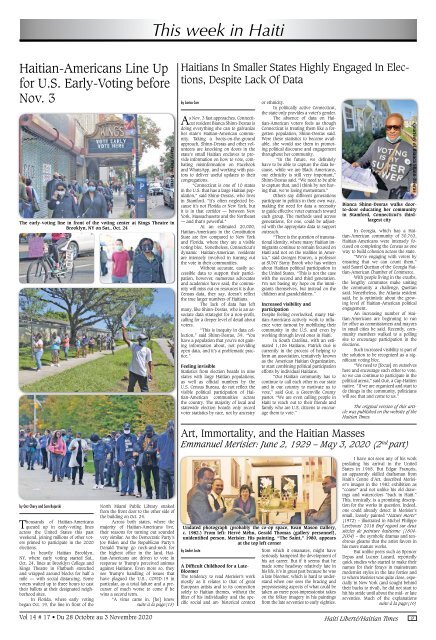Haiti Liberte 28 Octobre 2020
Create successful ePaper yourself
Turn your PDF publications into a flip-book with our unique Google optimized e-Paper software.
This week in <strong>Haiti</strong><br />
<strong>Haiti</strong>an-Americans Line Up<br />
for U.S. Early-Voting before<br />
Nov. 3<br />
The early-voting line in front of the voting center at Kings Theatre in<br />
Brooklyn, NY on Sat., Oct. 24<br />
Garry Pierre-Pierre<br />
<strong>Haiti</strong>ans In Smaller States Highly Engaged In Elections,<br />
Despite Lack Of Data<br />
by Larisa Carr<br />
As Nov. 3 fast approaches, Connecticut<br />
resident Bianca Shinn-Desras is<br />
doing everything she can to galvanize<br />
her state’s <strong>Haiti</strong>an-American community.<br />
Taking a boots-on-the-ground<br />
approach, Shinn-Desras and other volunteers<br />
are knocking on doors in the<br />
state’s small <strong>Haiti</strong>an enclaves to provide<br />
information on how to vote, combating<br />
misinformation on Facebook<br />
and WhatsApp, and working with pastors<br />
to deliver useful updates to their<br />
congregations.<br />
“Connecticut is one of 10 states<br />
in the U.S. that has a large <strong>Haiti</strong>an population,”<br />
said Shinn-Desras, who lives<br />
in Stamford. “It’s often neglected because<br />
it’s not Florida or New York, but<br />
it is in that corridor — between New<br />
York, Massachusetts and the Northeast<br />
— and that’s powerful.”<br />
At an estimated 20,000,<br />
<strong>Haiti</strong>an-Americans in the Constitution<br />
State are few compared to New York<br />
and Florida, where they are a visible<br />
voting bloc. Nonetheless, Connecticut’s<br />
dynamic <strong>Haiti</strong>an-American residents<br />
are intensely involved in turning out<br />
the vote in their communities.<br />
Without accurate, easily accessible<br />
data to support their participation,<br />
however, numerous advocates<br />
and academics have said, the community<br />
will miss out on resources it is due.<br />
Census data, they say, doesn’t reflect<br />
the true larger numbers of <strong>Haiti</strong>ans.<br />
The lack of data has left<br />
many, like Shinn-Desras, who is an associate<br />
data strategist for a non-profit,<br />
calling for a deeper level of detail about<br />
voters.<br />
“This is inequity in data collection,”<br />
said Shinn-Desras, 39. “You<br />
have a population that you’re not gaining<br />
information about, not providing<br />
open data, and it’s a problematic practice.”<br />
Feeling invisible<br />
Statistics from election boards in nine<br />
states with large <strong>Haiti</strong>an populations,<br />
as well as official numbers by the<br />
U.S. Census Bureau, do not reflect the<br />
visible political participation of <strong>Haiti</strong>an-American<br />
communities across<br />
the country. The majority of local and<br />
statewide election boards only record<br />
voter statistics by race, not by ancestry<br />
or ethnicity.<br />
In politically active Connecticut,<br />
the state only provides a voter’s gender.<br />
The absence of data on <strong>Haiti</strong>an-American<br />
voters feels as though<br />
Connecticut is treating them like a forgotten<br />
population, Shinn-Desras said.<br />
Were these statistics to become available,<br />
she would use them in promoting<br />
political discourse and engagement<br />
throughout her community.<br />
“In the future, we definitely<br />
have to be able to capture the data because,<br />
while we are Black Americans,<br />
our ethnicity is still very important,”<br />
Shinn-Desras said. “We need to be able<br />
to capture that, and I think by not having<br />
that, we’re losing momentum.”<br />
Others say different generations<br />
participate in politics in their own way,<br />
making the need for data a necessity<br />
to guide effective voter outreach toward<br />
each group. The methods used across<br />
generations, for one, could be adjusted<br />
with the appropriate data to support<br />
outreach.<br />
“There is the question of transnational<br />
identity, where many <strong>Haiti</strong>an immigrants<br />
continue to remain focused on<br />
<strong>Haiti</strong> and not on the realities in America,”<br />
said Georges Fouron, a professor<br />
at SUNY Stony Brook who has written<br />
about <strong>Haiti</strong>an political participation in<br />
the United States. “This is not the case<br />
with the second and third generation.<br />
I’m not basing my hope on the immigrants<br />
themselves, but instead on the<br />
children and grandchildren.”<br />
Increased visibility and<br />
participation<br />
Despite feeling overlooked, many <strong>Haiti</strong>an-Americans<br />
actively work to influence<br />
voter turnout by mobilizing their<br />
community in the U.S. and even by<br />
working through loved ones in <strong>Haiti</strong>.<br />
In South Carolina, with an estimated<br />
1,106 <strong>Haiti</strong>ans, Patrick Gué is<br />
currently in the process of helping to<br />
form an association, tentatively known<br />
as the American <strong>Haiti</strong>an Organization,<br />
to start combining political participation<br />
efforts by individual <strong>Haiti</strong>ans.<br />
“Our <strong>Haiti</strong>an community has to<br />
continue to call each other in our state<br />
and in our country to motivate us to<br />
vote,” said Gué, a Greenville County<br />
pastor. “We are even calling people in<br />
<strong>Haiti</strong> to reach out to their friends and<br />
family who are U.S. citizens to encourage<br />
them to vote.”<br />
Courtesy of Bianca Shinn-Desras<br />
Bianca Shinn-Desras walks doorto-door<br />
educating her community<br />
in Stamford, Connecticut’s thirdlargest<br />
city<br />
In Georgia, which has a <strong>Haiti</strong>an-American<br />
community of 30,763,<br />
<strong>Haiti</strong>an-Americans were intensely focused<br />
on completing the Census as one<br />
way to build cohesion across the state.<br />
“We’re engaging with voters by<br />
ensuring that we can count them,”<br />
said Saurel Quettan of the Georgia <strong>Haiti</strong>an-American<br />
Chamber of Commerce.<br />
With people living in the exurbs,<br />
the lengthy commutes make uniting<br />
the community a challenge, Quettan<br />
said. Nonetheless, the Atlanta resident<br />
said, he is optimistic about the growing<br />
level of <strong>Haiti</strong>an-American political<br />
engagement.<br />
An increasing number of <strong>Haiti</strong>an-Americans<br />
are beginning to run<br />
for office as commissioners and mayors<br />
in small cities he said. Recently, community<br />
members walked to a polling<br />
site to encourage participation in the<br />
elections.<br />
Such increased visibility is part of<br />
the solution to be recognized as a significant<br />
voting bloc.<br />
“We need to [focus] on ourselves<br />
here and encourage each other to vote,<br />
so we can continue to participate in the<br />
political arena,” said Gué, a Cap-Haïtien<br />
native. “If we are organized and start to<br />
do things in the community, politicians<br />
will see that and come to us.”<br />
The original version of this article<br />
was published on the website of the<br />
<strong>Haiti</strong>an Times.<br />
Art, Immortality, and the <strong>Haiti</strong>an Masses<br />
Emmanuel Merisier: June 2, 1929 – May 3, <strong>2020</strong> (2 nd part)<br />
by Onz Chery and Sam Bojarski<br />
Thousands of <strong>Haiti</strong>an-Americans<br />
queued up in early-voting lines<br />
across the United States this past<br />
weekend, joining millions of other voters<br />
primed to participate in the <strong>2020</strong><br />
elections.<br />
In heavily <strong>Haiti</strong>an Brooklyn,<br />
NY, where early voting started Sat.,<br />
Oct. 24, lines at Brooklyn College and<br />
Kings Theatre in Flatbush stretched<br />
and wrapped around blocks for half a<br />
mile — with social distancing. Some<br />
voters waited up to three hours to cast<br />
their ballots at their designated neighborhood<br />
sites.<br />
In Florida, where early voting<br />
began Oct. 19, the line in front of the<br />
North Miami Public Library snaked<br />
from the front door to the other side of<br />
the building on Oct. 24.<br />
Across both states, where the<br />
majority of <strong>Haiti</strong>an-Americans live,<br />
their reasons for turning out sounded<br />
very similar. As the Democratic Party’s<br />
Joe Biden and the Republican Party’s<br />
Donald Trump go neck-and-neck for<br />
the highest office in the land, <strong>Haiti</strong>an-Americans<br />
are driven to vote in<br />
response to Trump’s perceived animus<br />
against <strong>Haiti</strong>ans. Even more so, they<br />
see Trump’s handling of issues that<br />
have plagued the U.S., COVID-19 in<br />
particular, as a total failure and a precursor<br />
of much worse to come if he<br />
wins a second term.<br />
“A virus came in, [he] knew<br />
suite à la page(15)<br />
Undated photograph (probably the co-op space, Kean Mason Gallery,<br />
c. 1982.) From left: Hervé Méhu, Gerald Thomas (gallery personnel),<br />
unidentified person, Merisier. His painting, “The Saint,” 1980, appears<br />
at the top left corner<br />
by André Juste<br />
A Difficult Childhood for a Late-<br />
Bloomer<br />
The tendency to read Merisier’s work<br />
mostly as it relates to that of great<br />
European artists and to its connection<br />
solely to <strong>Haiti</strong>an themes, without the<br />
filter of his individuality and the specific<br />
social and art- historical context<br />
from which it emanates, might have<br />
seriously hampered the development of<br />
his art career. But if it seems that he<br />
made some headway relatively late in<br />
his life, it’s in great part because he was<br />
a late bloomer, which is hard to understand<br />
when one sees the bracing and<br />
prepossessing aspects of what could be<br />
taken as mere post-impressionist takes<br />
on the folksy imagery in his paintings<br />
from the late seventies to early eighties.<br />
I have not seen any of his work<br />
predating his arrival in the United<br />
States in 1968. But Edgar François,<br />
an apparently skilled draftsman from<br />
<strong>Haiti</strong>’s Centre d’Art, described Merisier’s<br />
images in the 1982 exhibition as<br />
“coarse” and not unlike his old drawings<br />
and watercolors “back in <strong>Haiti</strong>.”<br />
This, ironically, is a promising description<br />
for the works in question. Indeed,<br />
one could already detect in Merisier’s<br />
small, loosely painted “Nature morte”<br />
(1972) – illustrated in Michel Philippe<br />
Lerebours’ 2018 Bref regard sur deux<br />
siècles de peinture haitienne (1804-<br />
2004) – the symbolic dramas and tenebrous<br />
gleams that the artist favors in<br />
his more mature works.<br />
But unlike peers such as Spencer<br />
Depas and Lucner Lazard, reportedly<br />
quick studies who started to make their<br />
names for their forays in mainstream<br />
modernist styles in the late forties and<br />
to whom Merisier was quite close, especially<br />
in New York (and sought behind<br />
their backs to rival), he did not start to<br />
hit his stride until about the mid- or late<br />
seventies. Much of the explanations<br />
suite à la page(16)<br />
Vol 14 # 17 • Du <strong>28</strong> <strong>Octobre</strong> au 3 Novembre <strong>2020</strong><br />
<strong>Haiti</strong> Liberté/<strong>Haiti</strong>an Times<br />
9
















